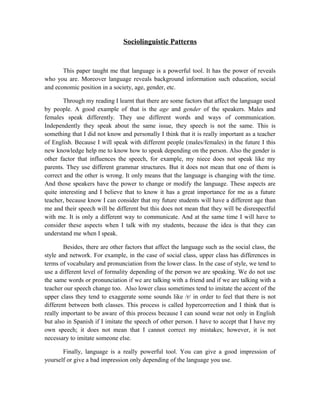
Sociolinguistic patterns reflection
- 1. Sociolinguistic Patterns This paper taught me that language is a powerful tool. It has the power of reveals who you are. Moreover language reveals background information such education, social and economic position in a society, age, gender, etc. Through my reading I learnt that there are some factors that affect the language used by people. A good example of that is the age and gender of the speakers. Males and females speak differently. They use different words and ways of communication. Independently they speak about the same issue, they speech is not the same. This is something that I did not know and personally I think that it is really important as a teacher of English. Because I will speak with different people (males/females) in the future I this new knowledge help me to know how to speak depending on the person. Also the gender is other factor that influences the speech, for example, my niece does not speak like my parents. They use different grammar structures. But it does not mean that one of them is correct and the other is wrong. It only means that the language is changing with the time. And those speakers have the power to change or modify the language. These aspects are quite interesting and I believe that to know it has a great importance for me as a future teacher, because know I can consider that my future students will have a different age than me and their speech will be different but this does not mean that they will be disrespectful with me. It is only a different way to communicate. And at the same time I will have to consider these aspects when I talk with my students, because the idea is that they can understand me when I speak. Besides, there are other factors that affect the language such as the social class, the style and network. For example, in the case of social class, upper class has differences in terms of vocabulary and pronunciation from the lower class. In the case of style, we tend to use a different level of formality depending of the person we are speaking. We do not use the same words or pronunciation if we are talking with a friend and if we are talking with a teacher our speech change too. Also lower class sometimes tend to imitate the accent of the upper class they tend to exaggerate some sounds like /r/ in order to feel that there is not different between both classes. This process is called hypercorrection and I think that is really important to be aware of this process because I can sound wear not only in English but also in Spanish if I imitate the speech of other person. I have to accept that I have my own speech; it does not mean that I cannot correct my mistakes; however, it is not necessary to imitate someone else. Finally, language is a really powerful tool. You can give a good impression of yourself or give a bad impression only depending of the language you use.